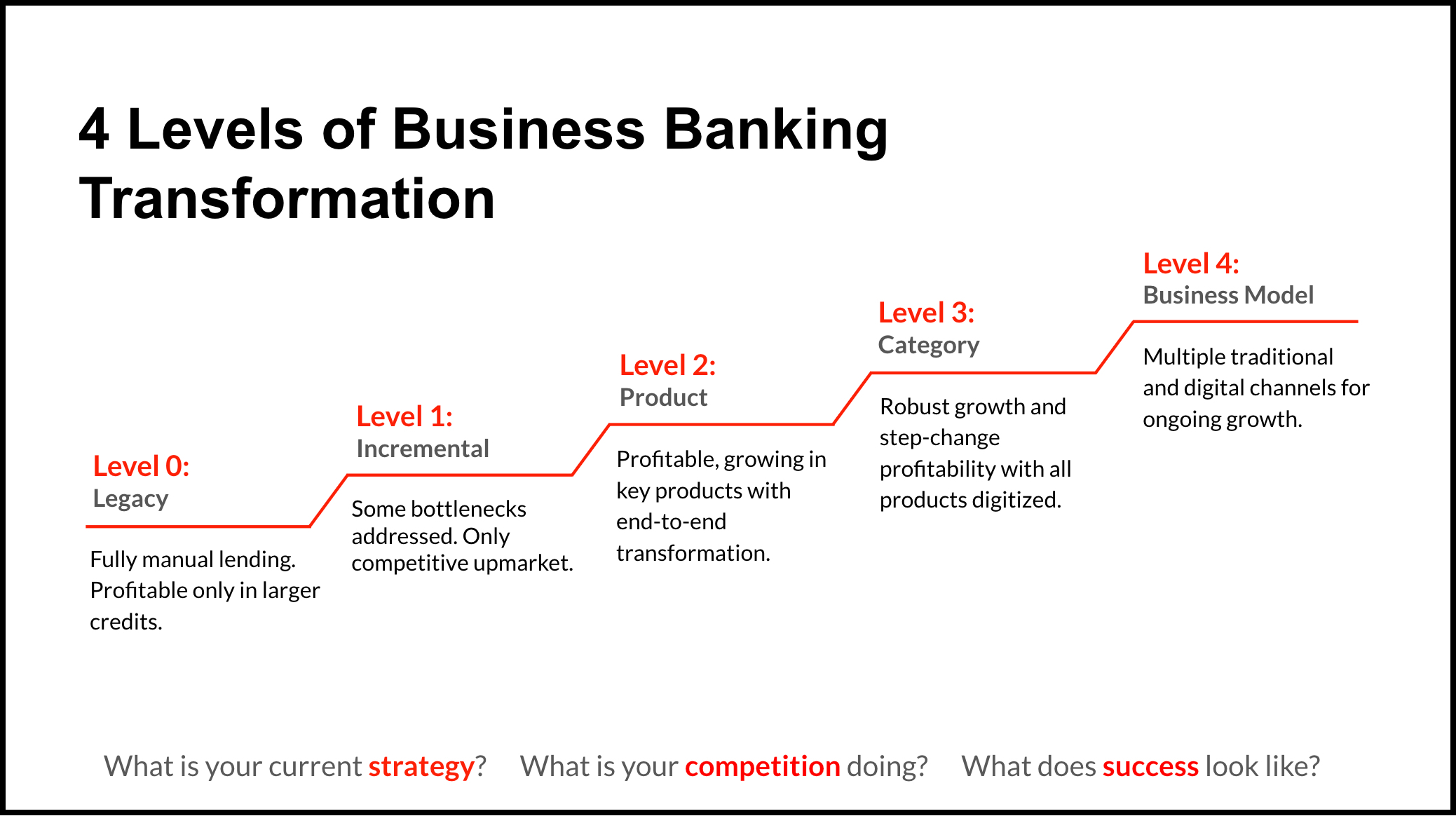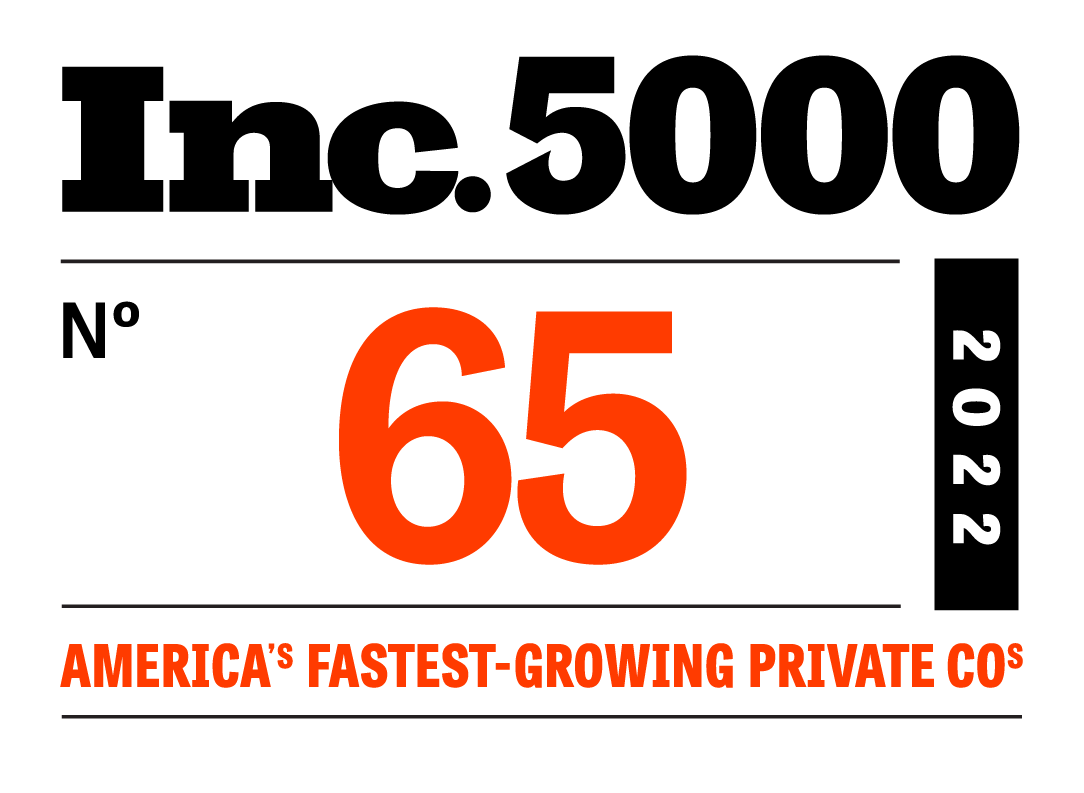
As leaders evaluate new technology for their financial institutions, it’s important to understand where they currently stand in their digital transformation journey, and what their goals are for the future, if they want to chart the best path forward.
To help banks and credit unions chart their path toward digital maturity, we’ve developed “The Digital Transformation Curve,” a method of categorizing the steps of a financial institution’s digital transformation journey from point solutions to business models.
The Four Levels of Business Banking Transformation
So, let's talk about what these levels are, based on Numerated’s experience digitizing $50B in commercial lending. They are:
- Level 0: Legacy. This describes financial institutions that have yet to invest in technology.
- Level 1: Incremental Improvement. This describes financial institutions that have invested in point solutions.
- Level 2: Financial Product Transformation. This describes financial institutions that have used technology to completely transform an individual product or service.
- Level 3: Full Category Transformation. This describes financial institutions that have used technology to completely transform an entire category of financial products or services.
- Level 4: Business Model Transformation. This describes financial institutions that have used technology to completely transform how they lend to businesses and go to market.
Every bank initially starts at the first level on the curve: legacy processes. All processes when you first start off are manual, which means either paper-based or Microsoft Excel-based, but 100 percent of the work is being performed by humans. That's fine, but obviously, it has a bunch of problems. For example, manual processes lack efficiency and they’re difficult to scale, giving them little chance at success in today’s increasingly digital market.
That said, for many institutions, evolving beyond legacy status is an important first step. That’s where Point solutions come into play.
Level 1: Incremental Improvement. Goal: Point Solutions to Resolve Bottlenecks.
A chief goal of digital transformation should be to address key bottlenecks in your business banking processes, and this is where we believe a lot of banks are today. A bottleneck might look like a lagging underwriting efficiency. It could be caused by constant back and forth between associates and customers. It could mean loan operations are falling. Every institution faces problems as they try to scale operationally.
This first level of digital transformation allows lenders to successfully scale operationally through digitizing a specific portion of the business loan origination process. There may be some efficiency benefits as well, but, at this step they're pretty minor. The main focus of this level is driving operational efficiency as you grow.
Level 2: Financial Product Transformation. Goal: Grow Profitably With Key Products.
The second level requires end-to-end transformation of a specific product, and there's a variety of playbooks in this level. Two areas of interest for many lenders today are unlocking the retail channel for small business and competing and winning in equipment lending. To compete in these spaces, you have to have a great process, and typically, traditional processes aren't good enough to win business relationships.
If you want to remain competitive, it's not going to be with your traditional manual process. So, this second level of transformation is all about profitable growth. You need to transform to win in certain products, such as in commercial lending.
Level 3: Full Category Transformation. Goal: Grow Profitably Through Key Categories.
The third level of transformation allows lenders to digitize all of the products within a certain category at the institution. This requires the individual product transformation of all of the products within a category.
This could be transforming all commercial and industrial lending, for example, or your entire small business segment. This brings a step-change level of profitability improvement where you can radically reduce costs. In fact, from our experience, you can cut 75 percent of your costs out if you fully digitally transform your product set in commercial banking.
Level 4: Business Model Transformation. Goal: Create New Channels for Growth.
The fourth and final level on the curve is the one where we are starting to see playbooks emerge for success as every bank is trying to figure out how to compete and win for the future. This is a transformation of your business model.
In this level, we see banks that are using digital transformation to open up new channels for growth. Lenders are evaluating new opportunities like embedding their loan products with fintechs, national direct banking, and branchless banking for business. Banking-as-a-Service is a topic being discussed in every bank boardroom in the country right now and we expect to see a number of banks get into this space in the next 12 months.
Beginning Your Business Banking Transformation Journey
While you think about the opportunities that await within each of these levels of transformation, you should consider the following three questions:
- What is your current strategy? In order to create a plan for the future, you must first identify where you’re at as an institution. It’s important to take a look at your current strategy and identify what’s working well, and how it can be improved.
- What is your competition doing? Competition can mean a lot of different things. It can mean the other bank that's been around the corner for 50 years. It can mean the big mega banks, new digital-only banks, or anybody running a level four playbook targeting customers in your neighborhood, that you don't even know about yet. It’s important for you to understand whom and what you’re competing against, as well as how you can differentiate yourself.
- What does success look like for your bank? This is a really important one to define. It’s not just success—broadly speaking—but understanding what success looks like for you in both the short and long term. Once you identify what this looks like, you can begin to seek out strategic partners to help you reach your goals.
Once you understand where your institution sits on the Digital Transformation Curve, taking the next step on your journey is as easy as choosing the right technology partner. Numerated has successfully partnered with more than 140 lenders to help transform the way they lend to business customers.
To learn more about how you can digitally transform your business banking segment, watch our recent webinar on Playbooks for Success in Small Business Lending.






